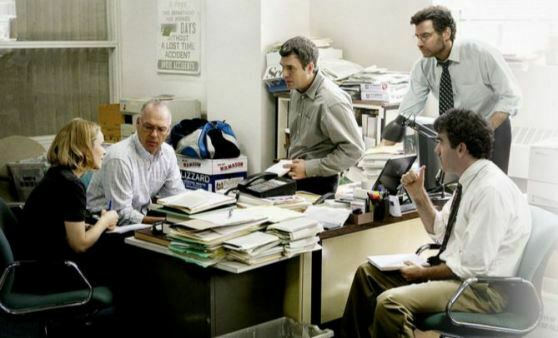
I went to the cinema this afternoon to see Spotlight, and I was very impressed. It is fully deserving of its Academy Award. It is not only a gripping, sobering account of priestly child abuse in Boston, but champions the noble practice of investigative journalism, highlighting the best of newspapers at a time when the form, and maybe investigative journalism as we have known it, is under threat. It also shines an understanding and positive light on archives and libraries, not only demonstrating their value, but making the dogged search for information through papers, bookshelves and directories seem as thrilling as any car chase. It is a film with a heart in all the right places.
But what impressed me most about the film was the shirts. This is a film where all of the men dress fabulously. Their shirts are immaculate, fresh off the hangers, scene after scene looking like it could have been posed for a clothing catalogue. Despite the late hours, the grimy spaces in which some lived or worked, and all the running around that they did, the journalists of the Boston Globe never failed to look at their very best.
Did they have a huge number of shirts at home? Did they iron assiduously in the little free time they had? Or were they making constant use of the best laundry service in the whole of America? I focussed on Michael Keaton (playing Walter ‘Robby’ Robinson) to see just how many shirts he got through. For a while it looked like he was wearing a different shirt for every scene, and I wondered just how large his wardrobe could possibly be, but then I started to see the same shirts come round again. He had to be using the world’s greatest laundry service, because those shirts were looking good as new every time.
It has been a much praised feature of Spotlight that it does not raise its journalist figures to heroic status, instead concentrating on the plain business of investigation. Nevertheless, they dress like angels. Now this could just be the costume designer ensuring that everyone looks their best, but a touch of grime on the shirt collars or a fading crease might have helped the sense of everyday realism that the film otherwise strives hard to achieve. As cleanliness is next to godliness, so signs of wear and tear denote imperfections within. That’s the logic of cinema.
A different kind of film would have explored the fallibilities of its heroes, or uncovered a dark past (say, for example, that one of them had been similarly abused as a child). But that would have taken the film away from its scrupulous historical recreation (all of the main characters are based on the actual Boston Globe ‘Spotlight’ investigative team which went on to win a Pulitzer Prize for its coverage of the scandal). It is story and the method that are in the spotlight, not the investigators. And so their shirts are perfect.
The real question is: who did the ironing? Them, wives or laundry…? I wear fewer shirts these days because I don’t want to face a mountain of ironing. Long live tee shirts!
I puzzled over that. Mark Ruffalo’s character claimed to be married, but his flat looked like a humble bachelor pad to me. On balance I suspect that they wore the shirts new and bought more than one of each style to keep up the constantly fresh appearance. No one can iron that well.
They gave the hint at the beginning that Ruffalo’s character had split from his wife (been kicked out? too much work not enough marriage??). By the time they showed his ‘home’ I was expecting a filthy bachelor pad (but, like the shirts it was fairly clean!).
I only half-picked up the mention to Ruffalo’s marriage, and didn’t know if there was a split or not, but noted that the pad was on the untended side, though not squalid. No sign of an ironing board, though.